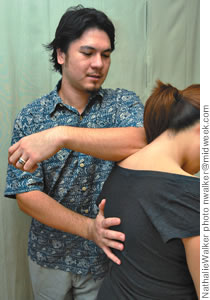When Your Back Is Tied Up In Knots

Friday - January 14, 2009
| Share
 Del.icio.us
Del.icio.us
|
The other night I just could not stay still in bed. All I could feel were these big, huge knots in my back and neck, and no matter which way I turned, it hurt.
I know I’m overdue for a massage, but I just haven’t had time to get one. Instead, I sit here hoping that these knots will magically go away on their own.
Yeah, right. “A knot is basically a bundling of muscle tissue, so it’s individual muscle fibers that are getting stuck together that are getting tangled, and over time they kind of build into a ball,” explains Reid Lyons, principal massage therapist at Quick Spa Massage Clinic in Waikiki. “There are two theories for what causes it. One would be overuse of the muscle tissue, and the second reason is over-stretching of the muscle tissue or muscle weakness.”
People usually feel tightness in the back of their upper shoulder because those muscles often are used for everyday things, such as lifting objects, carrying bags or purses, computer work and activities involving repetitive use of your arms and back, like surfing.
Also common are knots between the shoulder blades, which can be caused by sitting in front of the computer all day, resulting in tension in a person’s chest or front of their neck. When this happens, the muscles on the front are shortening and the muscles on the back are lengthening, which can lead to over-stretching.
To prevent knots, Lyons recommends good posture and being aware of your body movements so that there’s no unnecessary stress put on different muscles groups.
For people with desk jobs, make sure your equipment and work station are ergonomically correct. Your chair should be at the right height so that your knees are at a 90 degree angle, and your computer monitor should be at eye level so there’s no strain on the neck muscles. Also, criss-crossing your ankles or crossing your legs is a big no-no.
“If you criss-cross your legs you can feel your whole body shift, and as a compensation one side of your core gets tightened and the opposite side of the shoulder gets pulled down,” notes Lyons. “So there’s this zig-zag compensation that affects your body.”
Lyons also suggests using bags with a cross strap instead of a single shoulder strap, and avoid carrying heavy bags.
Also, exercise regularly. “If you have knots, there’s not so much you can do by yourself,” says Lyons. “You can put heat on it or a topical inflammatory ointment or even Aspirin to control the pain. But ultimately you will want to seek out a massage therapist who specializes in soft tissue injury or experience with trigger-point therapy.
“You want somebody who can actually break down the adhesion. They might do stretching to lengthen these muscles that have been really tight. And you want to also pick someone who is educated, so they can educate you as to why this is happening to you.”
Many spas and massage clinics offer a variety of treatments that, in the end, all sound good. But if you have knots in your body, it’s probably a good idea to familiarize yourself with the different treatments and the different therapists available.
“People will commonly ask for a deep-tissue massage, but I don’t always think it’s best to do this to a knot,” advises Lyons. “Sometimes, if they use deep pressure and the client feels a lot of pain, they might not be helping the problem. Instead, they might be adding to it by tearing the tissue.
“A lot of people think the harder the massage, the better it’s going to be. But it should be a gentle technique that actually feels like they can feel the release of the tissue. Basically, if you get a massage, it should not be extremely painful.”
As for whether or not knots can magically disappear on their own? I know, wishful thinking.
“The pain is not going to go away,” says Lyons. “The body is just going to get desensitized to the pain. And if they continue to do these things that are causing them to have that tension, it’s going to just keep piling up.
“That’s why some people have tiny knots and some people have really big, hard, dense knots. So, the longer you go without treatment, the harder it’ll be to fix it. And ultimately, it may result in some other type of condition. For example, some people get tension headaches, but it might be stemming from their shoulders being so tight that their head is not getting enough circulation for them to function.”
E-mail this story | Print this page | Comments (0) | Archive | RSS Comments (0) |
Most Recent Comment(s):













